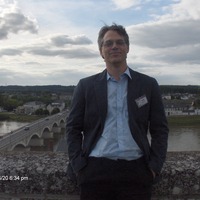Papers by Gregory Erickson
Palgrave Macmillan US eBooks, 2007
Christianity & Literature, 2009

Religion and the Arts, 2016
This essay focuses on two figures in James Joyce’s Ulysses, the heretic Arius and the vampire, wh... more This essay focuses on two figures in James Joyce’s Ulysses, the heretic Arius and the vampire, who when examined together address issues of anxiety over the body and artistic creation. Stephen’s early musings on Arius lead directly into his primary act of artistic creation, a poem he writes that begins, “He comes, pale vampire.” Like the heretic, the vampire will recede into the background, but will continue to haunt the novel, offering troubling and disruptive commentary on the narrative. Joyce’s less literal vampires have the ability to change forms—a rat in the cemetery, a bat flying over a church, ghosts of deceased characters, and a “black panther vampire”—and along with his paradigmatic heretic, Arius, they seem to float from the mind of character to character, forcing them to question received wisdom about creation, procreation, authority, succession, and the relationship of body to mind. Throughout the novel, heretics and vampires work as figures of disruption, as symbols of...
Comparative Literature, 2012

The Absence of God in Modernist Literature, 2007
Perhaps the two most famous defining moments of modernist music are the 1913 premiere of Igor Str... more Perhaps the two most famous defining moments of modernist music are the 1913 premiere of Igor Stravinsky’s Le Sacre du printemps and the 1908 premiere of Arnold Schoenberg’s Second String Quartet, Opus 10. While Le Sacre is most famous for the resulting riots, the last two moments of the Schoenberg Quartet, which also add a soprano voice, are often cited as the moment music arrived at absolute “atonality,” where there is no longer any sense of a pitch center around which the music is tonally organized. The performance, although it avoided the riots associated with Le Sacre, did incite controversy and dissent. Music critic Richard Batka wrote that “the majority of the public took against the work; various dissonances caused elegant ladies to utter cries of pain, putting their hands to their delicate ears, and elderly gentlemen to shed tears” (Reich 36). The text of the Quartet, by Stefan George, includes the phrase “Ich fuhle luft von anderem planeten,” (“I feel air from another planet”), which is often cited as appropriate for the strange new world that music seemed to be entering.
Investigating Firefly and Serenity
Devotional Interaction in Medieval England and its Afterlives

The Absence of God in Modernist Literature, 2007
One form of modernism’s contradictory rejection and acceptance of God is epitomized by James Joyc... more One form of modernism’s contradictory rejection and acceptance of God is epitomized by James Joyce’s A Portrait of the Artist as a Young Man. The 1916 novel is divided into five chapters, each of which can be seen as a struggle to come to terms with changing ideas of God and language. In the first section, a young Stephen Dedalus, discovering the confusing world of language, explores the gap between signifier and signified, asking and searching for something solid to attach the sounds of words to. He ponders the words “belt,” “suck,” and “kiss.” (“That was a belt round his pocket. And belt was also to give a fellow a belt” [5].) He wonders what each one can possibly mean, and he questions the perplexing variety and gradations of definitions words can have. Joyce develops each of these words into themes, exploring their different meanings throughout the novel. Stephen will experience “kiss,” for example, as a kiss from his mother, a kiss from a prostitute, and as the feel of the Host on his tongue. Finally, Stephen explores the word God. God was God’s name just as his name was Stephen. Dieu was the French for God and that was God’s name too; and when anyone prayed to God and said Dieu then God knew at once that it was a French person that was praying. But though there were different names for God in all the different languages in the world and God understood what all the people who prayed said in their different languages still God remained always the same God and God’s real name was God. (13, my emphasis)
The Absence of God in Modernist Literature, 2007
The pillar of fire and cloud leading the Israelites out of the desert in the final scene of Moses... more The pillar of fire and cloud leading the Israelites out of the desert in the final scene of Moses und Aron presensts a space of conflicting interpretation. To the Israelites, the pillar is the true God of Abraham; to Aron it is a symbol of God; to Moses it is an idolatrous image; and to the opera audience it is a special effect, an obvious illusion. The tension between these four interpretations defines the plural God of modernist literature, a God-idea that exists as presence and as nonpresence, as artistic trope and as superstitious remnant.

The Absence of God in Modernist Literature, 2007
In his expansive novel A la recherche du temps perdu,1 Marcel Proust employs the ancient metaphor... more In his expansive novel A la recherche du temps perdu,1 Marcel Proust employs the ancient metaphor of God as artist that was resurrected in the late nineteenth and early twentieth centuries. Nietzsche and the late nineteenth century had raised epistemological questions about the nature of God and art that needed to be grappled with, and authors such as Proust began to struggle with these issues through their use of metaphors of artistic creation and perception. That God functions as a metaphor in literature is accepted across disciplines and centuries. What God is a metaphor for is an unanswerable but necessary interpretive question at the heart of modern theology, philosophy, and literary critical theory. In this work, God has been a metaphor for totality, completeness, mystery, the inexpressible, and nothing, none of which are mutually exclusive. For Nietzsche, the creative artist “merges with the primal architect of the cosmos” (Birth of Tragedy 9); for Wallace Stevens, “God and the imagination are one” (Opus Posthumous 178). Each author, as Mark C. Taylor puts it, “displaces divine creativity onto human creativity,” (About Religion 208), and this move is also central in the work of Proust. Just as it takes the novel’s narrator a full year to come to a true recognition of the death of his grandmother, the narrator, Proust, and perhaps the whole twentieth century never fully realized Nietzsche’s death of God. The narrator only feels the absence of his grandmother in a moment of involuntary memory as he bends over to unbutton his boots—a type of the atheological absence of God embedded in the difficult web of Proust’s text.
The Absence of God in Modernist Literature, 2007
If in A la recherche art is religion, then music is God. Music, as has often been pointed out, is... more If in A la recherche art is religion, then music is God. Music, as has often been pointed out, is the central artistic medium for the narrator of the novel. Music appears in the novel as the greatest of the arts, and it provides the model on which the narrator seems to base his final epiphany. The music of the fictional composer Vinteuil and the famous “little phrase” resurface at important points throughout the work to both represent and initiate change in the narrator. Yet, like Plato’s khora, Derrida’s differance, and James’s bowl, Proust’s music, and in particular the “little phrase,” create a paradoxical God-idea that suggests a unity and denies its possibility. Music’s role in the novel strongly relates to and is created from the ideas surrounding the determinate and the indeterminate God.

The Absence of God in Modernist Literature, 2007
In 1965, J. Hillis Miller followed his book on Victorian poetry, The Disappearance of God, with P... more In 1965, J. Hillis Miller followed his book on Victorian poetry, The Disappearance of God, with Poets of Reality, a book on modernism. In the Introduction he wrote that “if the disappearance of God is presupposed by much Victorian poetry, the death of God is the starting point for many twentieth century writers.” In much modernist literature, as Miller described it, God, who was “once the creative sun, the power establishing the horizon where heaven and earth come together, becomes an object of thought like any other. When man drinks up the sea he also drinks up God, the creator of the sea” (2–3). God, it seemed, was now truly dead, and modernism had sounded the death knell. In locating modernism in this way, Miller was restating a familiar thesis. According to this narrative, modernist literature began from a newly perceived position of godlessness and was either creating an art out of the resulting nihilism or was creating a replacement for religion. These two positions—one negative and one positive—are represented in the words and works of modernists themselves. For Wallace Stevens, whose poetry often focused on the theme of re-creating lost religious ideas, God was the “supreme poetic idea” and “in the absence of a belief in God, the mind turns to its own creations” (Opus Posthumous 186). For Marcel Duchamp, on the other hand, it was “mad foolishness to have made up the idea of God” (Cabanne 107), and his art celebrates the meaninglessness of a godless world. However, more recent theories have recast the death of God as something more complex and creative; since the time of Miller’s book, both philosophers and theologians have come to see Nietzsche’s negation of the divine as more than just an antithesis to faith.

The Absence of God in Modernist Literature, 2007
The final scene of Act Two in Schoenberg’s opera Moses und Aron centers on a debate over the natu... more The final scene of Act Two in Schoenberg’s opera Moses und Aron centers on a debate over the nature of God. Upon returning from his forty-day absence, Moses accuses Aron of idolatry in constructing the Golden Calf, then destroys the Calf by speaking: “[B]egone you image of powerlessness to enclose the boundless in an image finite” (54). Aron explains that in Moses’s absence, “since the people had long expected both law and commandment soon … I was compelled to provide an image for them” (55). Aron justifies his actions by claiming he has performed “just my task as it ever has been” (55). Moses, who associates images with idolatry, asserts the greater power of the Word—“[y]our image faded at my word”—and then the ultimate superiority of the Idea: “Grant you now the power which idea has over both word and image?” (56). For Aron, the “idea” can only be made complete and functional through an image, and he contrasts his love for the people over Moses’s love for the idea, maintaining that for them, the image is the “perceivable part of the whole idea” (57).








Uploads
Papers by Gregory Erickson